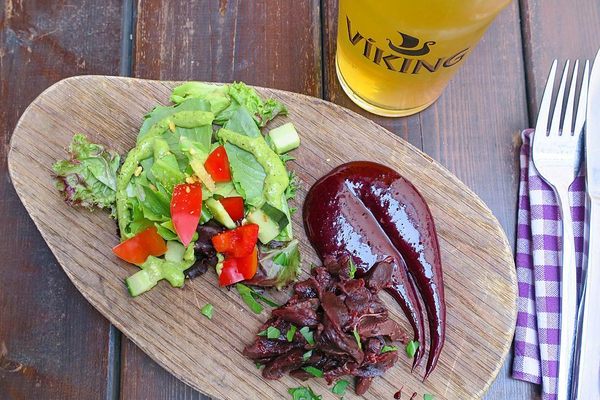Occasionally, a rogue squid beak gets lodged in a sperm whale’s intestines. To protect its soft innards against the sharp irritant, the animal produces a waxy secretion called ambergris (“gray amber”), much like an oyster forming a pearl. Excreted ambergris is turned into a rock-like mass by saltwater and sunshine. By the time the weather-beaten clump reaches shore, it may be worth thousands of dollars.
Unlike a pearl, this protective material isn’t much to look at, but its odor is something to behold. According to one molecular biologist who studies the substance, ambergris evokes “leaf litter on a forest floor” as well as “the delicate, frilly undersides of mushrooms that grow in damp and shaded places.”
Throughout history, ambergris has been most prized in perfumery, but cooks began publishing recipes using the substance around 1660. The English valued ambergris not only for its sweet and earthy fragrance, but because cooking with a luxury ingredient felt, well, luxurious. Early recipes skewed toward desserts and decadent dishes. Sweet and savory bread puddings were particularly popular: One recipe called for sweetened almonds, rose water, bread, cream, egg, sugar, nutmeg, bone marrow, and “muske and amber grease.” As the trend of ambergris-enhanced recipes continued into the 18th century, medicinal drinks, gelatins, and posset (an ale-spiked hot custard drink) all featured the substance. Eventually, perfume-y scents fell out of food fashion and were replaced by flavors such as vanilla.
Today, the substance once known as “gray amber” exists in a legal gray area. In the United Kingdom and European Union, beachcombers can safely scavenge for ambergris and sell it online. But in the United States, even though the Food and Drug Administration recognizes ambergris as safe, it’s illegal to possess or trade because sperm whales are protected by the Marine Mammal Protection Act of 1972.
However, because ambergris scavenging isn’t harmful to whales—and because the product is viewed as excrement—users aren’t typically prosecuted. Recently, food historian Sarah Lohman made multiple attempts at recreating a 17th-century recipe for ambergris ice cream. Tasters thought the better batch was pleasantly floral and mossy, while the lesser one evoked barnyard and armpit.
Written By
 rachelrummel
rachelrummel
Sources
- www.fourpoundsflour.com/the-history-dish-i-made-ambergris-ice-cream/
- www.foodrepublic.com/2013/06/26/what-is-ambergris-and-what-the-hell-is-it-doing-in-my-cocktail-glass/
- firstwefeast.com/eat/2016/07/ice-cream-flavor-history
- www.manuscriptcookbookssurvey.com/ambergris-the-perfume-of-whales-that-once-scented-foods/
- www.fourpoundsflour.com/the-history-dish-ambergris-ice-cream/
- us.whales.org/blog/2015/09/ambergris-lucky-lucrative-and-legal
- food52.com/blog/16686-why-you-may-be-drinking-whale-excrement-soon
- www.manuscriptcookbookssurvey.com/collection/index.php/Detail/manuscripts/125
- www.nmfs.noaa.gov/pr/species/mammals/whales/sperm-whale.html
- www.smithsonianmag.com/arts-culture/a-taste-of-edible-feces-111178660/
- www.ambergris.co.nz/identification
- www.accessdata.fda.gov/scripts/cdrh/cfdocs/cfcfr/CFRSearch.cfm?fr=582.50
- www.nhm.ac.uk/discover/what-is-ambergris.html














